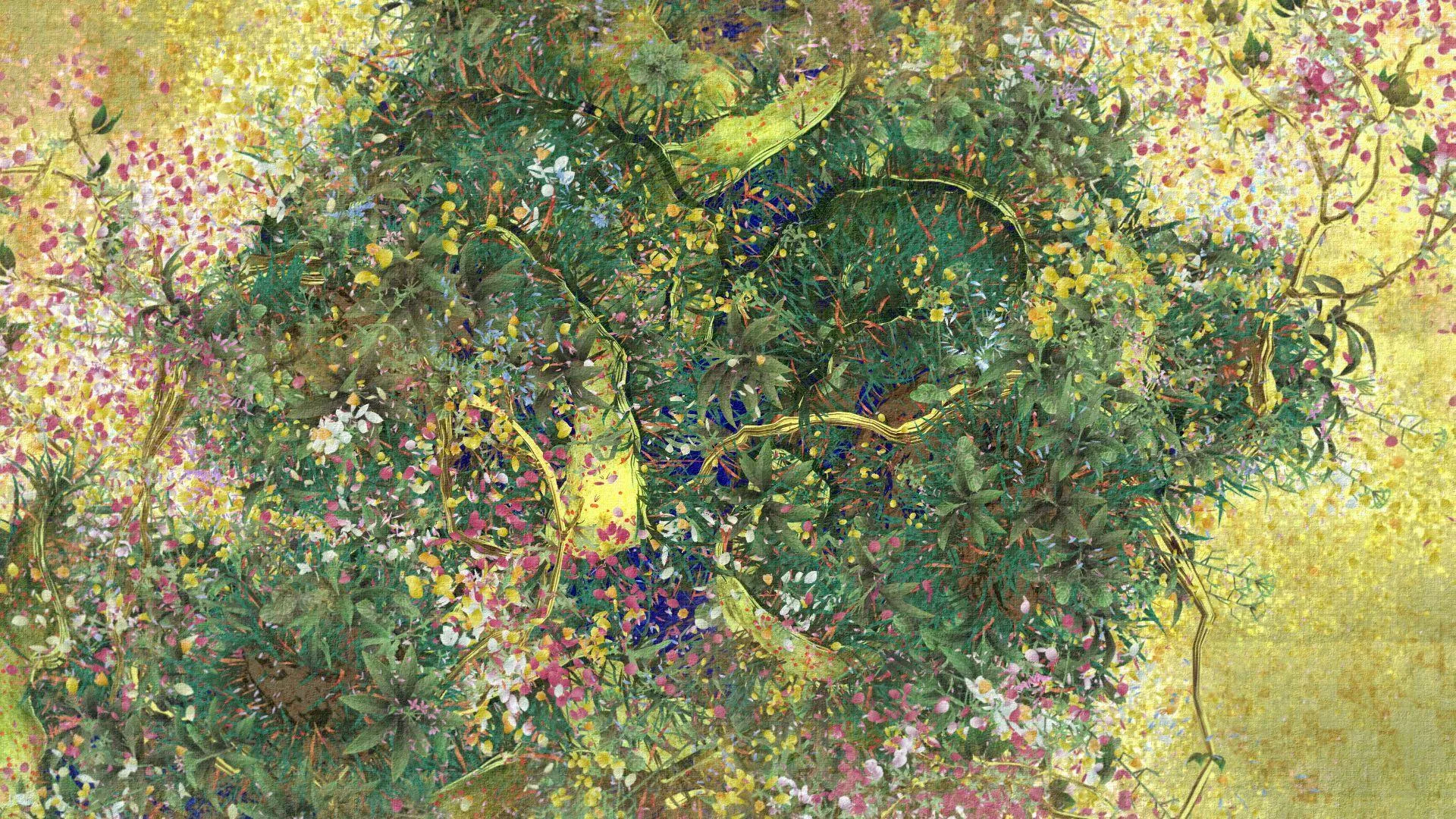

Time-blossoming Flowers
teamLab, 2014, Digital Work
Together at this time we inherit history and space; in the past, present, and future, people are connected and continue to connect. For this work teamLab wishes to express the continuing connections of people over time through endless blooming flowers.
This work is created continuously in real-time in increments of hours, days, and years.
Every hour, on the hour, all the flowers fall together in a shower of blossoms. The number of blooms then gradually increases throughout each hour. At 30 minutes past the hour, for example, about half of all the flowers are blooming.
The look of the work changes throughout the day. It grows light with the sunrise, glows with the sunset as the sun goes down, and grows dark as the night deepens. It works in sync with the actual sunrise and sunset every day at this location.
The flowers that are blooming vary throughout the year. They are always turning into different Japanese seasonal flowers to coincide with the passing seasons.
Just as the natural landscape is not the same twice, what we see in the artwork now, cannot be viewed twice. The picture is being created over time, and the picture that you see is always for the first time.
Traditional Japanese art is often referred to as being planar, but we at teamLab believe that there is a different logical construction of space to that of the perspective of the West. We call that "Ultra Subjective Space". This work is based on that logic of Ultra Subjective Space. The world was constructed in three-dimensions, in three-dimensional space, and then it was made to be planar in line with what we believe to be the logical structure of spatial recognition of Japanese art.
Flowers of the Seasons
January: Daffodil, Christmas Camellia, Cineraria
February: Japanese Apricot, Daffodil, Cineraria, Rapeseed
March: Winter Daphne, Daffodil, Cineraria, Rapeseed, Japanese Apricot
April: Cherry Blossom, Daffodil, Cineraria, Rapeseed, Milkvetch
May: Rabbit Ear iris, Milkvetch, Tickseed, Weigela Hortensis
June: Hydrangea, Lily, Japanese Bellflower, Japanese Stewartia
July: Japanese Morning Glory, Lily, Japanese Bellflower, Crape Myrtle
August: Sunflower, Lily, White Rain Lily, Crape Myrtle
September: Red Spider Lily, White Rain Lily, Cosmos, Crape Myrtle
October: Fragrant Olive, Cosmos, Nippon Daisy, Pansy
November: Florist's Daisy, Cosmos, Nippon Daisy, Florist's Cyclamen, Pansy
December: Christmas Camellia, Florist's Daisy, Florist's Cyclamen, Pansy
※Some of the trees with flowers in this work have the motif of the holly tree, Ilex latifolia. When the underside of the leaves of this tree are scratched they leave a dark mark. As the mark remains for a long period of time it is said that the leaves were used to write on, and it is thought that this is the etymology of the japanese word for postcard (which consists of the characters for ‘leaf’ and ‘word”), and as to why it is sometimes called the Post Office tree. Ilex latifolia trees have existed in front of this JP Tower since the era of the Tokyo Central Post Office. The Ilex latifolia inside this work will change with the seasons, to flower and fruit.
This work is created continuously in real-time in increments of hours, days, and years.
Every hour, on the hour, all the flowers fall together in a shower of blossoms. The number of blooms then gradually increases throughout each hour. At 30 minutes past the hour, for example, about half of all the flowers are blooming.
The look of the work changes throughout the day. It grows light with the sunrise, glows with the sunset as the sun goes down, and grows dark as the night deepens. It works in sync with the actual sunrise and sunset every day at this location.
The flowers that are blooming vary throughout the year. They are always turning into different Japanese seasonal flowers to coincide with the passing seasons.
Just as the natural landscape is not the same twice, what we see in the artwork now, cannot be viewed twice. The picture is being created over time, and the picture that you see is always for the first time.
Traditional Japanese art is often referred to as being planar, but we at teamLab believe that there is a different logical construction of space to that of the perspective of the West. We call that "Ultra Subjective Space". This work is based on that logic of Ultra Subjective Space. The world was constructed in three-dimensions, in three-dimensional space, and then it was made to be planar in line with what we believe to be the logical structure of spatial recognition of Japanese art.
Flowers of the Seasons
January: Daffodil, Christmas Camellia, Cineraria
February: Japanese Apricot, Daffodil, Cineraria, Rapeseed
March: Winter Daphne, Daffodil, Cineraria, Rapeseed, Japanese Apricot
April: Cherry Blossom, Daffodil, Cineraria, Rapeseed, Milkvetch
May: Rabbit Ear iris, Milkvetch, Tickseed, Weigela Hortensis
June: Hydrangea, Lily, Japanese Bellflower, Japanese Stewartia
July: Japanese Morning Glory, Lily, Japanese Bellflower, Crape Myrtle
August: Sunflower, Lily, White Rain Lily, Crape Myrtle
September: Red Spider Lily, White Rain Lily, Cosmos, Crape Myrtle
October: Fragrant Olive, Cosmos, Nippon Daisy, Pansy
November: Florist's Daisy, Cosmos, Nippon Daisy, Florist's Cyclamen, Pansy
December: Christmas Camellia, Florist's Daisy, Florist's Cyclamen, Pansy
※Some of the trees with flowers in this work have the motif of the holly tree, Ilex latifolia. When the underside of the leaves of this tree are scratched they leave a dark mark. As the mark remains for a long period of time it is said that the leaves were used to write on, and it is thought that this is the etymology of the japanese word for postcard (which consists of the characters for ‘leaf’ and ‘word”), and as to why it is sometimes called the Post Office tree. Ilex latifolia trees have existed in front of this JP Tower since the era of the Tokyo Central Post Office. The Ilex latifolia inside this work will change with the seasons, to flower and fruit.